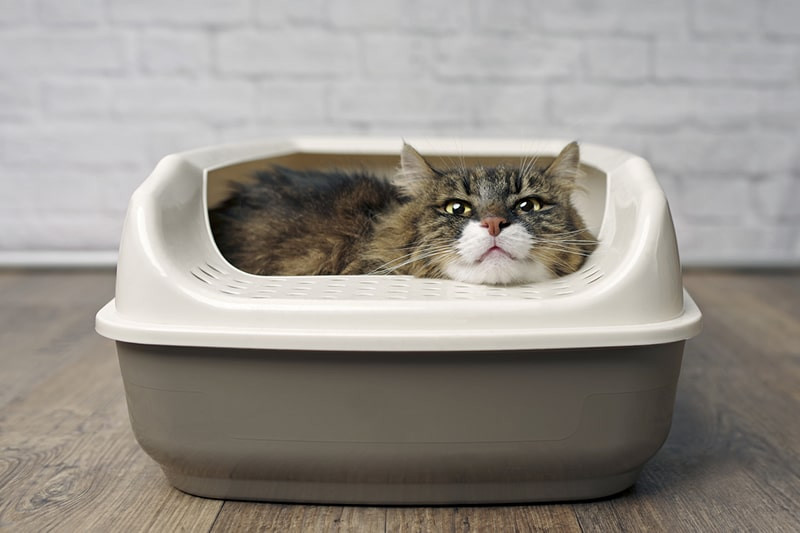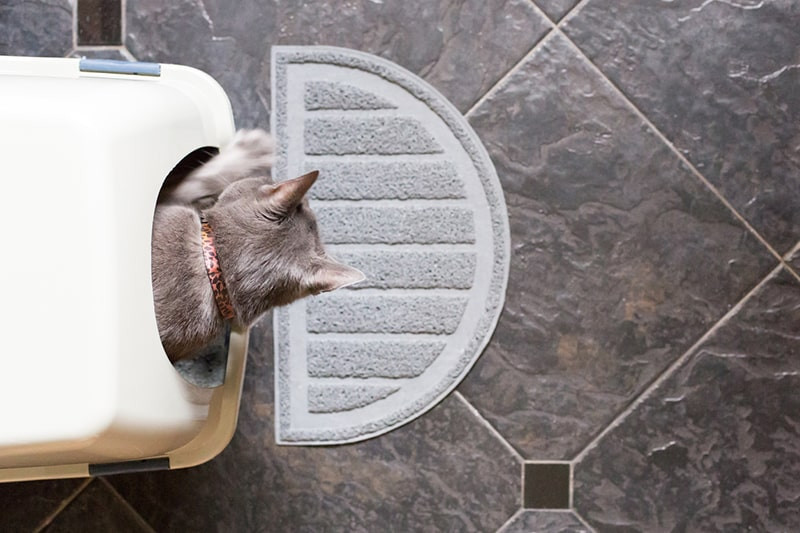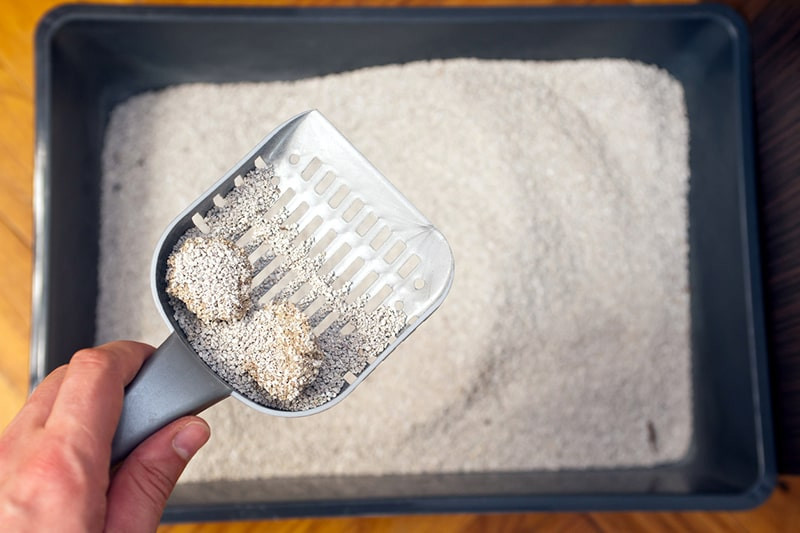Everyone does it, and our feline friends are no exception! Poop, while not the most glamorous topic, is a crucial indicator of your cat’s health. As a dedicated cat owner, you’ve probably wondered, “How Often Do Cats Poop?” Understanding your cat’s bowel movements can provide valuable insights into their digestive health and overall well-being. This guide will delve into the world of cat poop, helping you decipher what’s normal, what’s not, and when it’s time to consult your veterinarian.
 tabby cat resting in a litter box
tabby cat resting in a litter box
What’s Considered a Normal Poop Frequency for Cats?
There’s no one-size-fits-all answer to the question of how often a cat should poop. The frequency of bowel movements can vary significantly from cat to cat. Just like humans, each cat has its own rhythm. However, a general guideline is that most cats will poop once or twice a day.
This frequency can be influenced by several factors, including:
- Diet: A cat’s diet plays a significant role in their digestive regularity. The type of food, fiber content, and digestibility all impact how often they need to eliminate waste.
- Age: Kittens might poop more frequently than adult cats due to their faster metabolism and smaller digestive systems. Senior cats might experience changes related to age or underlying health conditions.
- Health: Illnesses, stress, and changes in routine can all disrupt a cat’s normal pooping schedule. Digestive issues can lead to more frequent or less frequent bowel movements.
- Hydration: Proper hydration is essential for healthy digestion and regular bowel movements. Dehydration can lead to constipation and less frequent pooping.
While once or twice a day is typical, some healthy cats might poop slightly more or less often. The key is to observe your cat’s individual pattern and become familiar with what’s normal for them. Significant deviations from their usual routine are what should raise a flag.
 gray cat exiting a covered litter box
gray cat exiting a covered litter box
Decoding Healthy Cat Poop: What to Look For
Beyond frequency, the characteristics of your cat’s poop itself are vital indicators of their digestive health. Healthy cat poop has a few key features:
- Color: Healthy cat poop is typically dark brown. Variations in shade are possible depending on diet, but consistently very light or very dark poop can be a sign of a problem.
- Consistency: The ideal consistency is firm but not too hard, and not too soft or runny. Think of it like modeling clay. It should be formed and hold its shape, but not be rock-solid or mushy.
- Smell: Cat poop will never smell like roses, but excessively foul-smelling poop that makes you recoil could indicate digestive upset or infection. A moderate odor is normal.
- Shape: Healthy cat poop is usually log-shaped or cylindrical. Small, hard pellets can indicate constipation, while loose, unformed poop points to diarrhea.
When Cat Poop Frequency Changes: Red Flags and What They Mean
Changes in your cat’s pooping habits, whether in frequency or appearance, can signal potential health issues. It’s important to be observant and know when to seek veterinary advice.
Pooping Too Frequently: If your cat is suddenly pooping much more often than usual, it could be a sign of:
- Dietary Indiscretion: They might have eaten something that disagreed with them, causing digestive upset.
- Food Intolerance or Allergy: New allergies or intolerances can develop at any stage of a cat’s life.
- Parasites: Intestinal parasites like roundworms are common in cats and can lead to increased bowel movements and diarrhea.
- Hyperthyroidism: This condition can speed up metabolism, sometimes resulting in more frequent defecation.
- Inflammatory Bowel Disease (IBD): IBD can cause chronic inflammation in the digestive tract, leading to changes in bowel habits.
- Colitis: Inflammation of the colon can also lead to more frequent, often urgent, bowel movements.
Pooping Too Infrequently or Not At All (Constipation): If your cat is straining to poop, producing only small, hard stools, or hasn’t pooped in 24-48 hours, they might be constipated. Potential causes include:
- Dehydration: Insufficient water intake can harden stools and make them difficult to pass.
- Low Fiber Diet: Fiber helps add bulk to stool and aids in smooth passage through the digestive tract.
- Hairballs: Excessive grooming can lead to hair accumulation in the digestive tract, causing blockages.
- Obstruction: Swallowing foreign objects can create intestinal blockages and constipation.
- Tumors or Growths: In rare cases, growths in the intestines can obstruct normal bowel function.
- Underlying Illnesses: Conditions like diabetes can sometimes contribute to constipation.
Diarrhea: Watery, loose stools are a clear sign of diarrhea. As mentioned, this can be caused by various factors, including diet, parasites, infections, and underlying illnesses.
Blood in Cat Poop: Observing blood in your cat’s stool is always concerning.
- Bright red blood usually indicates bleeding in the lower digestive tract, possibly due to straining from constipation or minor irritation.
- Dark, tarry blood suggests bleeding higher up in the digestive system and is a more serious concern.
Any presence of blood in your cat’s poop warrants a veterinary check-up to determine the cause.
Common Causes of Cat Poop Problems
Several underlying conditions can manifest as changes in your cat’s poop. Understanding these potential causes can help you be proactive about their health.
Inflammatory Bowel Disease (IBD): As mentioned earlier, IBD is a chronic condition involving inflammation of the gastrointestinal tract. This inflammation can disrupt normal digestion and absorption, leading to diarrhea, vomiting, and changes in poop frequency and consistency.
Stress and Anxiety: Cats are sensitive creatures, and stress or anxiety can significantly impact their digestive system. Changes in routine, new environments, or household stress can all contribute to digestive upset and poop problems.
Dietary Issues: Food intolerances, allergies, or simply eating inappropriate foods can wreak havoc on a cat’s digestive system. Sudden diet changes should also be avoided as they can cause temporary digestive upset.
Parasites: Intestinal parasites like roundworms, hookworms, and Giardia are common in cats, especially kittens and outdoor cats. These parasites can irritate the intestines and cause diarrhea and other digestive issues.
Infections: Bacterial, viral, or fungal infections can also affect the digestive tract and lead to changes in poop.
 scooping out a cat litter box
scooping out a cat litter box
Addressing Cat Constipation: Helping Things Move Along
If you suspect your cat is constipated, prompt action is essential. Mild constipation can sometimes be resolved at home, but persistent or severe cases require veterinary attention.
What You Can Do at Home (for Mild Cases):
- Increase Water Intake: Ensure your cat has access to fresh, clean water at all times. Consider adding wet food to their diet to increase hydration. You can also try enticing them to drink more by using a water fountain.
- High Fiber Diet: Switching to a diet higher in fiber can help add bulk to stools and ease passage. There are specialized high-fiber cat foods available, or you can discuss fiber supplements with your vet.
- Exercise: Encouraging physical activity can stimulate bowel movements. Play sessions and interactive toys can help get your cat moving.
When to See a Vet for Constipation:
- If home remedies don’t provide relief within 24-48 hours.
- If your cat is showing signs of pain or discomfort.
- If you suspect a blockage or underlying illness.
- If constipation is a recurring problem.
Your veterinarian can diagnose the cause of constipation and recommend appropriate treatment, which may include stool softeners, laxatives, or addressing any underlying medical conditions. In severe cases, manual removal of impacted stool or even surgery might be necessary.
The Danger of Blood in Cat Poop: Don’t Ignore It
As mentioned, blood in cat poop is a reason for concern and warrants veterinary attention. While a small amount of bright red blood might be due to minor straining, it’s crucial to rule out more serious causes.
Possible Causes of Blood in Cat Poop:
- Constipation and Straining: As mentioned, minor rectal bleeding can occur due to straining.
- Parasites: Certain parasites can cause intestinal inflammation and bleeding.
- Infections: Bacterial or viral infections can damage the intestinal lining and lead to blood in the stool.
- Food Allergies or Intolerances: Inflammation from allergies can cause bleeding.
- Polyps or Tumors: Growths in the colon or rectum can bleed.
- Bowel Obstruction: Obstructions can cause significant intestinal damage and bleeding.
- Anal Gland Issues: While less common in poop itself, anal gland problems can sometimes be mistaken for blood in the stool area.
When to See a Vet: Always consult your veterinarian if you notice blood in your cat’s poop, especially if it’s persistent, dark, or accompanied by other symptoms like lethargy, vomiting, or loss of appetite.
Cat Poop and Toxoplasmosis: Understanding the Risk
Toxoplasmosis is a parasitic infection caused by Toxoplasma gondii. Cats can become infected by eating infected prey animals (like rodents or birds) or raw meat. While handling cat poop might seem concerning in relation to Toxoplasmosis, the risk of transmission to humans is relatively low with proper hygiene.
Key Facts about Toxoplasmosis and Cat Poop:
- Cats only shed the parasite in their feces for a short period (usually 1-3 weeks) after initial infection. Once they’ve shed it, they typically develop immunity and don’t shed it again unless their immune system is severely compromised.
- The parasite in cat feces needs to sporulate (become infective) for at least 24-48 hours after being passed. Daily litter box scooping significantly reduces the risk of infection.
- Humans are more commonly infected by eating undercooked or raw meat or through gardening in contaminated soil than through cat poop.
Precautions to Minimize Risk:
- Pregnant women should avoid cleaning litter boxes. If it’s unavoidable, wear gloves and wash hands thoroughly afterward. Toxoplasmosis can be harmful to unborn babies.
- Scoop the litter box daily. This removes potentially infectious feces before the parasite becomes infective.
- Wash hands thoroughly after handling cat litter or feces.
- Keep cats indoors. Indoor cats are less likely to hunt and become infected with Toxoplasmosis.
Why is My Cat Pooping Outside the Litter Box? Addressing Inappropriate Elimination
If your cat suddenly starts pooping outside the litter box, it’s important to investigate the cause. It’s rarely “just” behavioral; there’s usually an underlying reason.
Possible Reasons for Pooping Outside the Box:
- Medical Issues: Urinary tract infections, kidney disease, diabetes, arthritis, and digestive problems can all make it painful or difficult for a cat to use the litter box, leading to accidents outside the box. Always rule out medical causes first with a vet check.
- Litter Box Aversion: Cats can be very particular about their litter boxes. Factors that can lead to aversion include:
- Cleanliness: Cats prefer clean litter boxes. Scoop daily!
- Location: Boxes should be in quiet, private, and accessible locations.
- Size: The box should be large enough for the cat to comfortably turn around and eliminate.
- Type of Box: Some cats prefer open boxes, while others prefer covered ones. Experiment to see what your cat likes.
- Litter Type: Cats can be picky about litter texture and scent. Sudden changes in litter can cause aversion.
- Number of Boxes: The general rule is one litter box per cat plus one extra.
- Stress and Anxiety: Changes in the household, new pets, or stress can lead to inappropriate elimination as a way for cats to express their distress.
- Territorial Marking: While less common with poop than urine, in some cases, defecating outside the box can be a form of territorial marking, especially in multi-cat households.
 devon rex cat sitting in a clumping cat sand in litter box
devon rex cat sitting in a clumping cat sand in litter box
Addressing Litter Box Issues:
- Rule out medical problems with a vet visit.
- Evaluate litter box cleanliness, location, size, type, and litter. Make adjustments as needed based on your cat’s preferences.
- Provide enough litter boxes, especially in multi-cat homes.
- Reduce stress and anxiety by providing a stable routine, safe spaces, and addressing any known stressors.
- Clean accidents thoroughly with enzymatic cleaners to eliminate odors that might attract the cat back to the same spot.
Dealing with Litter Kicking: Containing the Mess
Many cat owners struggle with cats who enthusiastically kick litter out of the box. While some litter scatter is inevitable, excessive kicking can be frustrating.
Tips to Minimize Litter Kicking:
- Covered Litter Box: A covered box can help contain some of the kicked litter.
- Litter Mat: Place a litter mat under the box to catch scattered litter. Mats with textured surfaces are particularly effective at trapping litter.
- High-Sided Litter Box: Boxes with higher sides can prevent litter from being kicked out as easily.
- Less Clumping Litter (Sometimes): Some cats kick more with clumping litter. Trying a non-clumping or different type of clumping litter might help.
- Litter Box Placement: Position the box in a corner or against a wall to limit the direction litter can be kicked.
Understanding your cat’s pooping habits is an essential part of responsible cat ownership. By paying attention to frequency, appearance, and any changes, you can gain valuable insights into their health and well-being. If you ever have concerns about your cat’s poop, don’t hesitate to consult with your veterinarian – they are your best partner in keeping your feline friend healthy and happy.
Disclaimer: This article provides general information for educational purposes only and should not be considered a substitute for professional veterinary advice. Always consult with your veterinarian for any health concerns or before making any decisions related to your cat’s health or treatment.
